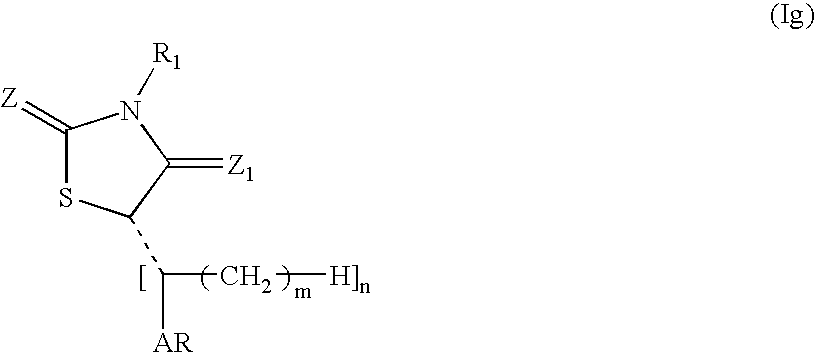Pin1-Modulating compounds and methods of use thereof
a technology of modulating compounds and compounds, applied in the field of pin1modulating compounds, can solve the problem of dramatic misexpression of pin1
- Summary
- Abstract
- Description
- Claims
- Application Information
AI Technical Summary
Benefits of technology
Problems solved by technology
Method used
Image
Examples
example 1
Cell Based Cytotoxicity Assay (CBCA) of Pin1 Modulating Compounds
[0406] Mammalian cells were seeded in 96 well flat bottom microtiter plates at a density of 5,000 6000 cells per well on day 0 in 0.1 mL of an appropriate growth media. On Day 1, the wells were aspirated and 0.1 mL of fresh media was added. The cells were then treated with 0.01 mL of 10× drug dilutions in 10% DMSO in media and incubated at 37° C. in a humidified, 5% CO2 atmosphere. The assay contained eight drug concentrations in triplicate as well as a triplicate control where cells were treated with 0.01 mL of 10% DMSO in media. On Day 4, the cells were incubated with 0.02 mL of a colorimetric cell-viability assay solution (MTS) prepared from 20 parts (3-(4,5-dimethylthiazol-2-yl)-5-(3-carboxymethoxyphenyl)-2-(4-sulfophenyl)-2H-tetrazolium (Promega) at 2.0 mg / mL in PBS and 1 part phenazine methosulfate (Sigma) at 0.92 mg / mL in PBS for 2-3 hours at 37° C. Background wells were prepared by incubating 0.02 mL of the co...
example 2
Specificity Assay for Inhibition of Proline Isomerase by Pin1 Modulating Compounds
[0408] The proline isomerase activity assay is based on the method described by Fisher et al. (Biomed. Biochim. Acta, 1984, 43: 1101-1111). Specifically, the enzyme (3 ng) was preincubated with 236 μM substrate at 4° C. for 30 minutes in an 80 μL reaction volume containing 0.1 mg / μL BSA, 0.2 mM DTT, and 35 mM HEPES (pH 7.8). Proteolysis of the substrate was initiated by the addition of 80 μL of trypsin at 0.4 mg / mL in 35 mM HEPES (pH 7.8) and the release of p-nitroaniline was monitored every 10 seconds at 390 nm using a microplate reader (MRD / 8V / DIAS, Dynex Technologies). Inhibition studies were preformed by adding 5 μL of inhibitors added in the pre-incubation mix. Inhibitors were at 0.4 mg / mL in 10% DMSO.
[0409] Multiple activity-based assays at multiple dilutions, performed as described above, were used to generate the curve from which the IC50 was determined. As shown below, several IC50 results w...
example 3
Specificity Assay for Inhibition of Pin1 by Pin1 Modulating Compounds
[0410] The specificity of the Pin1 inhibitor compounds of the invention can be determined by the protease-coupled PPIase assay developed by Fischer et al. (Biomed. Biochim. Acta, 1984, 43: 1101-1111). For example, the enzyme activity of Pin1 can be compared to members of the other known classes of PPIases, cyclophilins (e.g., hCyp18, hCyP-A, hCyP-B, hCyP-C, and NKCA) and FKBPs (e.g., hFKBP12, hFKBP-12, hFKBP-13, and hFKBP-25) in the presence and absence of the compound.
[0411] In one assay, hPin1 activity measurements are determined using bovine trypsin (final concentration 0.21 mg / mL, Sigma) as an isomer specific protease and Ac-Ala-Ala-Ser(P)-Pro-Arg-pNA (Jerini, Germany) as a substrate. PPIase activity of hFKBP12 (Sigma) and hCyp18 (Sigma) is determined with the peptide substrate Suc-Ala-Phe-Pro-Phe-pNA (Bachem) and the protease α-chymotrypsin (final concentration 0.41 mg / mL, Sigma). The test can be performed b...
PUM
 Login to View More
Login to View More Abstract
Description
Claims
Application Information
 Login to View More
Login to View More - R&D
- Intellectual Property
- Life Sciences
- Materials
- Tech Scout
- Unparalleled Data Quality
- Higher Quality Content
- 60% Fewer Hallucinations
Browse by: Latest US Patents, China's latest patents, Technical Efficacy Thesaurus, Application Domain, Technology Topic, Popular Technical Reports.
© 2025 PatSnap. All rights reserved.Legal|Privacy policy|Modern Slavery Act Transparency Statement|Sitemap|About US| Contact US: help@patsnap.com



